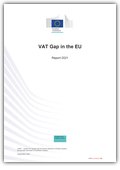 Homepage CASE
Homepage CASE
Selected values

VAT Gap in the EU. Report 2021
-

Mikhail Bonch-Osmolovsky
Economist
Dr. Mikhail Bonch-Osmolovskiy is a Senior Economist and in-house CASE statistician and econometrician. He holds Ph.D. in Economics obtained in the Department of Economics, University of North Carolina at Chapel Hill. His research interests include construction ofsurvey-based price indices for time and regional adjustments from the raw data, imputation of household rents via hedonic regressions. … <a href="https://case.dev10.pro/publications/vat-gap-in-the-eu-report-2021-2/">Continued</a>
Articles from this author:
-
VAT gap in the EU. Report 2023
This Report has been prepared for the European Commission, DG TAXUD, for the project TAXUD/2019/AO-14, “Study and Reports on the VAT Gap in the EU-28 Member States”, and is a follow-up to the eight reports published between 2013 and 2020. The report provides yearly Value Added Tax (VAT) Gap estimates for the EU-28 covering the … Continued
-
VAT Gap in the EU. Report 2022
VAT is one of the core sources of government revenue in the EU. Meeting the fiscal objective of VAT requires confronting the key challenge of taxpayer non-compliance with VAT payment obligations. It also requires sensible decisions regarding narrowing the tax base or reducing VAT liability for certain parts of the tax base. The relevance … Continued
-
Study and Reports on the VAT Gap in the EU-28 Member States. 2020 Final Report
This Report has been prepared for the European Commission, DG TAXUD, for the project TAXUD/2019/AO-14, “Study and Reports on the VAT Gap in the EU-28 Member States”, and is a follow-up to the seven reports published between 2013 and 2019. This Study contains Value Added Tax (VAT) Gap estimates for 2018, fast estimates using a … Continued
-
VAT gap in the EU. Report 2023
-

Adam Śmietanka
Economist
Adam Śmietanka is an Economist at CASE. His areas of expertise include data analysis, data visualization, web scraping, and inflation measurement. At CASE, Mr. Śmietanka is responsible for conducting data analysis, economic research, and developing and maintaining CASE’s online monthly consumer price index. His professional experience includes an internship with PwC’s Advisory Team and a … <a href="https://case.dev10.pro/publications/vat-gap-in-the-eu-report-2021-2/">Continued</a>
Articles from this author:
-
VAT compliance gap due to Missing Trader IntraCommunity (MTIC) fraud – Final report: phase 1
The phenomenon of Missing Trader Intra-Community fraud (MTIC fraud) stands out as a significant form of VAT fraud. In this scheme, a fraudulent trader sells goods and services to other businesses, collects the VAT from customers, and then vanishes without remitting it to tax authorities. Despite variations in assessments of its exact scale, both revealed … Continued
-
VAT gap in the EU. Report 2023
This Report has been prepared for the European Commission, DG TAXUD, for the project TAXUD/2019/AO-14, “Study and Reports on the VAT Gap in the EU-28 Member States”, and is a follow-up to the eight reports published between 2013 and 2020. The report provides yearly Value Added Tax (VAT) Gap estimates for the EU-28 covering the … Continued
-
VAT Gap in the EU. Report 2022
VAT is one of the core sources of government revenue in the EU. Meeting the fiscal objective of VAT requires confronting the key challenge of taxpayer non-compliance with VAT payment obligations. It also requires sensible decisions regarding narrowing the tax base or reducing VAT liability for certain parts of the tax base. The relevance … Continued
-
VAT compliance gap due to Missing Trader IntraCommunity (MTIC) fraud – Final report: phase 1
Related publications
Thanks for joining us!
You're now part of a community that values [your newsletter's focus]. Get ready to stay informed, inspired, and engaged with our carefully curated content.
